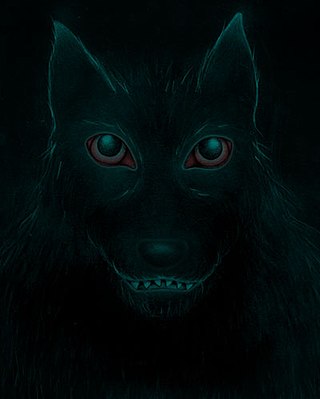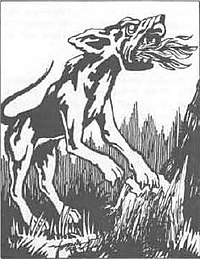
The Wild Hunt is a folklore motif occurring across various northern European cultures. Wild Hunts typically involve a chase led by a mythological figure escorted by a ghostly or supernatural group of hunters engaged in pursuit. The leader of the hunt is often a named figure associated with Odin in Germanic legends, but may variously be a historical or legendary figure like Theodoric the Great, the Danish king Valdemar Atterdag, the dragon slayer Sigurd, the Welsh psychopomp Gwyn ap Nudd, biblical figures such as Herod, Cain, Gabriel, or the Devil, or an unidentified lost soul either male or female. The hunters are generally the souls of the dead or ghostly dogs, sometimes fairies, valkyries, or elves.

In Greek mythology, Orthrus or Orthus was, according to the mythographer Apollodorus, a two-headed dog who guarded Geryon's cattle and was killed by Heracles. He was the offspring of the monsters Echidna and Typhon, and the brother of Cerberus, who was also a multi-headed guard dog.
In Welsh mythology and folklore, Cŵn Annwn, singular Ci Annwn, were the spectral hounds of Annwn, the otherworld of Welsh myth. They were associated with a form of the Wild Hunt, presided over by either Arawn, king of Annwn in Pwyll Pendefig Dyfed, the First Branch of the Mabinogi and alluded to in Math fab Mathonwy the Fourth Branch of the Mabinogi, or by Gwyn ap Nudd as the underworld king and king of the fair(y) folk is named in later medieval lore.
Qiqirn is a large, bald dog spirit in Inuit mythology, from around the area of Baffin Island. It has hair only on its feet, mouth and the tips of its ears and tail. Its presence will send men and dogs into convulsions, sometimes fatal. However, it is frightened of humans and will run away if an angakkuq sees it. A similar term, also from Inuit mythology, is keelut, a malevolent earth spirit which also appears as a hairless dog.

The púca, pucapwca, pooka, phouka, puck is a creature of Celtic, English, and Channel Islands folklore. Considered to be bringers both of good and bad fortune, they could help or hinder rural and marine communities. Púcaí can have dark or white fur or hair. The creatures were said to be shape-changers that could take the appearance of horses, goats, cats, dogs, and hares. They may also take a human form, which includes various animal features, such as ears or a tail.

In English folklore, Black Shuck, Old Shuck, Old Shock or simply Shuck is the name given to a ghostly black dog which is said to roam the coastline and countryside of East Anglia, one of many such black dogs recorded in folklore across the British Isles. Accounts of Black Shuck form part of the folklore of Norfolk, Suffolk, the Cambridgeshire Fens and Essex, and descriptions of the creature's appearance and nature vary considerably; it is sometimes recorded as an omen of death, but, in other instances, is described as companionable.
In Northern English folklore, the Barghest or Barguest is a mythical monstrous black dog with large teeth and claws, though in other cases the name can refer to a ghost or household elf, especially in Northumberland and Durham, such as the Cauld Lad of Hylton.

The church grim is a guardian spirit in English and Nordic folklore that oversees the welfare of a particular Christian church, and protects the churchyard from those who would profane and commit sacrilege against it. It often appears as a black dog but is known to take the form of other animals. In modern times, when black dogs are kept as pets in churches and their attached parsonages, these are called church Grims since they reside on and guard ecclesiastical property.
The gwyllgi is a mythical dog from Wales that appears as a frightful apparition of a mastiff or Black Wolf with baleful breath and blazing red eyes. It is the Welsh incarnation of the black dog figure of English folklore.

Inugami, like kitsunetsuki, is a spiritual possession by the spirit of a dog, widely known about in western Japan. They seemed firmly rooted until recent years in eastern Ōita Prefecture, Shimane Prefecture, and a part of Kōchi Prefecture in northern Shikoku, and it is also theorized that Shikoku, where no foxes (kitsune) could be found, is the main base of the inugami. Furthermore, traces of belief in inugami exists in the Yamaguchi Prefecture, all of Kyushu, even going past the Satsunan Islands all the way to the Okinawa Prefecture. In the Miyazaki Prefecture, the Kuma District, Kumamoto Prefecture, and Yakushima, the local dialect pronounces it "ingami" and in Tanegashima, they are called "irigami." It can also be written in kanji as 狗神.

The black dog is a supernatural, spectral, or demonic hellhound originating from English folklore that has also been seen throughout Europe and the Americas. It is usually unnaturally large with glowing red or yellow eyes, is often connected with the Devil, and is sometimes an omen of death. It is sometimes associated with electrical storms, and also with crossroads, barrows, places of execution and ancient pathways.

Dogs have played a role in the religion, myths, tales, and legends of many cultures. They hold diverse and multifaceted roles in various religious traditions around the globe. These interpretations often revolve around the faithful and loyal nature of dogs, paralleling human devotion to higher powers.

In the Dungeons & Dragons fantasy role-playing game, the term monster refers to a variety of creatures, some adapted from folklore and legends and others invented specifically for the game. Included are traditional monsters such as dragons, supernatural creatures such as ghosts, and mundane or fantastic animals. A defining feature of the game, is that monsters are typically obstacles that players must overcome to progress through the game. Beginning with the first edition in 1974, a catalog of game monsters (bestiary) was included along with other game manuals, first called Monsters & Treasure and now called the Monster Manual. As an essential part of Dungeons & Dragons, many of its monsters have become iconic and recognizable even outside D&D, becoming influential in video games, fiction, and popular culture.
*Ḱérberos is the reconstructed name of the canine creature guarding the entrance to the Otherworld in Proto-Indo-European mythology. In a recurrent motif, the Otherworld contains a gate, generally guarded by a dog who could also serve as a guide and ensured that the ones who entered could not get out.










